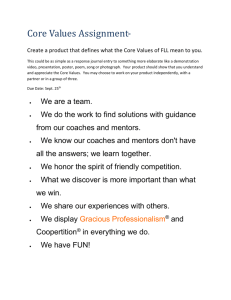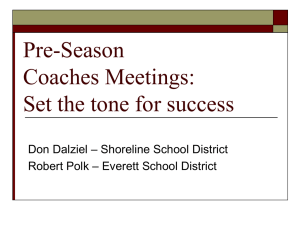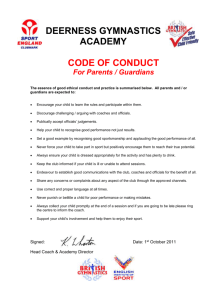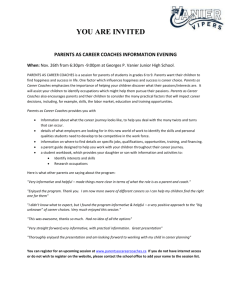Coaching to Love the Game - Fullerton Rangers Youth Soccer Club
advertisement
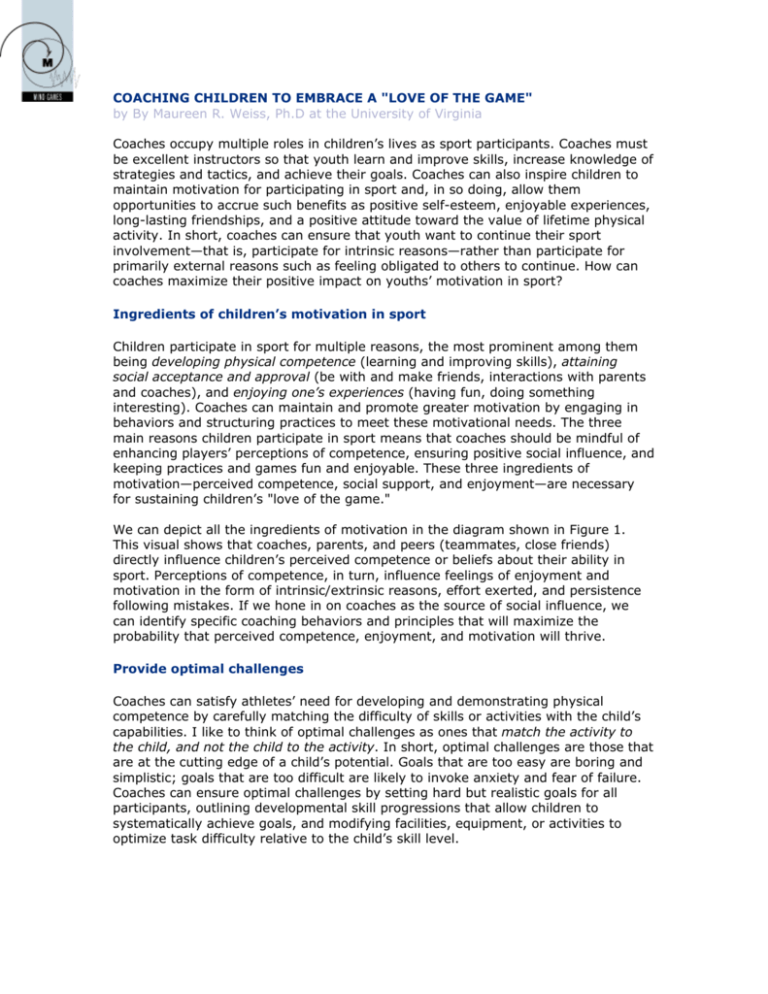
COACHING CHILDREN TO EMBRACE A "LOVE OF THE GAME" by By Maureen R. Weiss, Ph.D at the University of Virginia Coaches occupy multiple roles in children’s lives as sport participants. Coaches must be excellent instructors so that youth learn and improve skills, increase knowledge of strategies and tactics, and achieve their goals. Coaches can also inspire children to maintain motivation for participating in sport and, in so doing, allow them opportunities to accrue such benefits as positive self-esteem, enjoyable experiences, long-lasting friendships, and a positive attitude toward the value of lifetime physical activity. In short, coaches can ensure that youth want to continue their sport involvement—that is, participate for intrinsic reasons—rather than participate for primarily external reasons such as feeling obligated to others to continue. How can coaches maximize their positive impact on youths’ motivation in sport? Ingredients of children’s motivation in sport Children participate in sport for multiple reasons, the most prominent among them being developing physical competence (learning and improving skills), attaining social acceptance and approval (be with and make friends, interactions with parents and coaches), and enjoying one’s experiences (having fun, doing something interesting). Coaches can maintain and promote greater motivation by engaging in behaviors and structuring practices to meet these motivational needs. The three main reasons children participate in sport means that coaches should be mindful of enhancing players’ perceptions of competence, ensuring positive social influence, and keeping practices and games fun and enjoyable. These three ingredients of motivation—perceived competence, social support, and enjoyment—are necessary for sustaining children’s "love of the game." We can depict all the ingredients of motivation in the diagram shown in Figure 1. This visual shows that coaches, parents, and peers (teammates, close friends) directly influence children’s perceived competence or beliefs about their ability in sport. Perceptions of competence, in turn, influence feelings of enjoyment and motivation in the form of intrinsic/extrinsic reasons, effort exerted, and persistence following mistakes. If we hone in on coaches as the source of social influence, we can identify specific coaching behaviors and principles that will maximize the probability that perceived competence, enjoyment, and motivation will thrive. Provide optimal challenges Coaches can satisfy athletes’ need for developing and demonstrating physical competence by carefully matching the difficulty of skills or activities with the child’s capabilities. I like to think of optimal challenges as ones that match the activity to the child, and not the child to the activity. In short, optimal challenges are those that are at the cutting edge of a child’s potential. Goals that are too easy are boring and simplistic; goals that are too difficult are likely to invoke anxiety and fear of failure. Coaches can ensure optimal challenges by setting hard but realistic goals for all participants, outlining developmental skill progressions that allow children to systematically achieve goals, and modifying facilities, equipment, or activities to optimize task difficulty relative to the child’s skill level. Maximize social support Acceptance and approval by adults and peers strongly influence children’s perceptions of competence, enjoyment, and motivation. Coaches can make an impact on these elements in several ways. First, they can provide frequent and contingent informational feedback on how to improve skills. The term contingent means specific to or directly related to level of performance. For example, a baseball coach might praise a player for executing correct technique in hitting a ball to the opposite field, and then follow-up with information on how to get out of the batters box and up the line to first base more quickly. In response to a skill error, focusing on information for improving on the next attempt, rather than punishing the error, is a contingent and effective means of motivating players to sustain their effort. The literature clearly shows that frequent, contingent instruction by the coach to enhance sport skills and strategies sends a message to players that they have the ability to improve, and this is a motivating factor. A second means of coaches providing social support is through contingency and quality of praise and criticism. Contingent praise might be our baseball coach reinforcing a player for making the correct decision in response to a fielder’s choice, while contingent criticism might be constructively questioning a player for committing a mental error on a play he/she has mastered many times before. This latter behavior should suggest to the athlete that the coach believes he/she has the ability to do better. This brings us to the term quality of praise and criticism. Quality refers to the appropriateness of the feedback. Is it too much or too little? For what level of performance or task difficulty is it given? The general rule to ensure quality or appropriate feedback is: (a) don’t give excessive praise, (b) don’t give praise for mediocre performance, and (c) don’t give praise for success at easy tasks that everybody can do. Make sure sport experiences are fun Fun does not have to solely mean pizza or McDonalds after the game. Enjoyment can be part of the fabric of practices and competitions. Children and adolescents experience fun when there are opportunities for high levels of action, personal involvement in the action, and affirming friendships. Activities during practice could be structured to maximize action by eliminating waiting in line, ensuring sufficient equipment, and keeping things moving with short but intense and varied activities. Children also enjoy having some input to their experiences. Although coaches certainly make up the practice plan and orchestrate the pace and content of activities, children can be part of the decision-making process such as choosing warm-up drills or an activity at the end of practice. Providing some opportunity for autonomy translates to greater fun and enjoyment. Create a mastery motivational climate The motivational climate refers to how the learning environment is structured, what behaviors are valued, and how individuals are evaluated. A mastery motivational climate is one in which success and valued behaviors are defined in self-referenced terms such as learning, effort, and improvement, and mistakes are viewed as part of the learning process. By contrast, a performance motivational climate is one that emphasizes normreferenced definitions of success such as comparison to teammates’ performances and game outcome. The sport environment is one that contains some mixture of both mastery and performance climates. The key is for coaches to recognize, praise, and emphasize athletes’ personal improvements because such actions are under athletes’ control and thus more motivating than emphasizing peer comparisons. The acronym TARGET identifies elements of a mastery motivational climate, and also reinforces some of our earlier coaching concepts. TARGET includes: Task (optimal challenges v. standardized goals), Authority (player choice v. coach-directed only), Recognition (reinforcing effort and improvement, not only outcome), Grouping (cooperative teamwork v. competitive orientation), Evaluation (assessing improvement v. normative criteria), and Time (adequate time for learning and improvement). Help children help themselves Coaches can also motivate athletes by teaching them self-regulated learning strategies, which allow children to depend on themselves, not only adults, to monitor and evaluate their skill improvement and performance. Self-regulated learning consists of self-observation, self-judgment, and self-reinforcement. These processes refer to monitoring one’s behaviors to assess progression toward skills, comparing one’s current performance with desired goals, and reacting positively or negatively concerning progress toward goal achievement. Strategies such as goal setting, reframing negative to positive self-talk, and encouraging adoption of effort attributions for performance setbacks allow children a constructive means of evaluating their progress and readjusting their sights, maintaining a positive mental attitude rather than getting down on themselves, and seeking out alternative strategies as a means of problem solving rather than ascribing skill errors to factors outside of their control. Take-home messages Coaching to embrace a "love of the game" means understanding that multiple reasons underlie children’s participation patterns. The major reasons children play sports is to develop and demonstrate physical competence, experience positive social interactions with adults and peers, and have fun and enjoyable times. These three reasons form the ingredients of intrinsic motivation—one that is synonymous with an inherent desire to continue involvement. To maximize motivation, coaches can positively affect children’s sport experiences by providing optimal challenges, maximizing social support, ensuring enjoyable activities, creating a mastery motivational climate, and helping children help themselves. Each of these principles can be easily customized with sport-specific examples, and applied during practices and competitive events to maintain, sustain, and enhance children’s "love of the game.”


